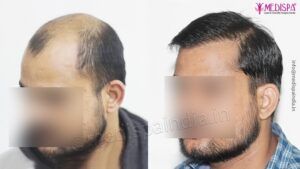
Genetic hair loss or androgenic alopecia, which causes oversensitive hair follicles and pattern baldness, is also known as hereditary hair loss. The effects of androgenic hormone cause the hair follicles to thin, which results in hair loss. Although pattern baldness affects men more frequently than women, both genders exhibit different patterns of baldness. Women typically experience more central thinning, but men typically experience developing baldness in the frontal and vertex regions.
It is clear that this pattern baldness is irreversible, and the best course of action is to consult a doctor. The best elective treatment for hair loss is a hair transplant, which will help you combat hair loss permanently.
The hair transplant in Jaipur is becoming more and more popular both nationally and among overseas. In foreign countries, hair transplants are quite expensive, and the majority of people are unable to benefit from them because the cost may rise significantly. On the other hand, the hair transplant cost in Jaipur is fairly reasonable, even when high-quality services are provided at a few clinics there. People also have the option of travelling to India to receive an equally excellent hair transplant at a more reasonable price. Let’s quickly review hair transplantation and its procedures.
TECHNIQUES TO PERFORM HAIR TRANSPLANT
By moving hair grafts from the donor site to the recipient site, or more simply by implanting hair follicles at the bald area that are extracted from the donor areas of your body, hair transplant operations are less invasive. The permanent root-bearing areas, which are often the sides and back of the head or, alternatively, body hairs, must necessarily be the donor locations.
The following explanations differentiate between two separate hair transplant processes based on the method of harvesting:
FUT hair transplantation, also known as the strip method, entails the removal of a small strip from the donor area, which is subsequently divided in order to extract the individual hair grafts. Trichophytic closure, a cutting-edge technique, is used to sew back the donor site, allowing it to heal securely and leave little to no visible scarring.
FUE hair transplant: Hair grafts are individually removed from the donor area using a punch instrument in the FUE hair transplant process.
These individual, microscopic hair follicular grafts are transplanted at the appropriate bald area after being harvested or extracted from the donor area.
When FUT hair transplant can be an effective technique?
In the following situation, the FUT procedure is a successful hair transplant technique:
- When the bald region is extensive: FUT hair transplantation is a favoured method in class Norwood IV or V stage instances with more extensive bald areas.
- When more follicular grafts are required: The FUT procedure allows for the extraction of 3000–3500 follicular grafts, which is a higher number than is often required.
- When it is necessary to avoid shaving: Nowadays, individuals choose to forgo shaving, which is a possibility with the FUT hair transplant process. For female hair transplant patients, shaving is specifically avoided because it can be a humiliating experience.
- Lowest follicular transection rate (FTR): The FUT procedure is efficient since it has the lowest FTR. In order to reduce the risk of damaging the hair follicles, this process uses high magnification microscopy to dissect the follicular grafts.
- To avoid violating the safe donor region: The FUT procedure is effective when a greater number of grafts are required since it preserves the donor area and prevents overharvesting.
- When further sittings are needed: FUT technology allows several strip extractions throughout various sessions, giving the opportunity to address increasing hair loss in additional sittings.
On the other hand, the FUE hair transplant method is favored in situations of early baldness where fewer hair follicles are needed.
Is FUT better than FUE hair transplant technique?
Ideally. The decision of which technique to use is based on the advantages and limitations of both strategies. However, neither of the two techniques is superior, and each is chosen carefully. The FUE technique is becoming increasingly popular and is frequently marketed as the best approach, which is untrue. The FUE technique is regarded as a quick and uncomplicated process that requires minimum equipment and labour. The FUT technique is a slightly more difficult procedure that needs considerable infrastructure and a lot of labour. Both FUT and FUE are technique-sensitive procedures that need for exceptional ability and knowledge to produce the best results. The majority of the time, FUT is the method of choice for hair transplantation due to its several additional benefits over FUE.
Combining FUT with FUE is the ideal procedure in severe cases of hair loss, such as Norwood classes VI or VII, if the requisite number of hair follicular grafts cannot be obtained using one technique alone. Over the two separate procedures, this one has the added benefit of collecting more than 4000 grafts while also protecting the donor site for future use.







